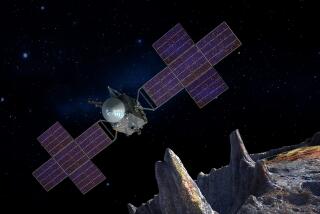Asteroid mining firm aims to raise $20 million in funding
A group of private entrepreneurs is raising $20 million to fund the first stage of a mission to identify asteroids close to Earth and mine them for valuable materials.
Deep Space Industries plans to launch three small crafts armed with cameras, called Fireflies, on an asteroid discovery mission as early as 2015. Three more spacecrafts, called Dragonflies, are expected to launch in 2016 to collect samples to be evaluated for mining potential.
Planetary Resources, a Seattle company that launched its asteroid-mining operation last year, is developing a space telescope for spaceflight soon.
More than 9,000 near-Earth asteroids have been recorded, according to NASA. Some have a diameter larger than a kilometer and are packed with valuable materials such as nickel and rare earth metals used for electronics.
Experts believe that asteroid mining could become its own industry. The Keck Institute for Space Studies, a Caltech think tank, said in a study last year that the technology to capture and mine asteroids exists.
Deep Space Industriesâ founders called asteroid mining a potential âgold rushâ during an unofficial launch event Tuesday at the Santa Monica Museum of Flying.
The company, based in McLean, Va., plans to pay satellite companies to allow its 55-pound Fireflies to ride piggyback on existing launches of commercial satellites at a cost of about $1 million per launch. In space, the Fireflies will fan out to take pictures of potentially valuable asteroids, soaring as far as four times the distance to the moon.
The yet-to-be-built Dragonfly spacecraft would grab samples of likely asteroids and bring them back to Earth for analysis.
Larger crafts then would be used to tow the best asteroids into Earthâs orbit, where the materials could be mined to create products, such as heat shields and fuel, for space missions.
Deep Space Industries has a patent pending on a 3-D-printing process that can create high-strength metal objects from schematics in zero-gravity conditions. Co-founder David Gump, who negotiated and directed the first TV commercial filmed on the Mir space station, said that building a prototype of the printer is expected to cost about $500,000. Products from the printer could be used to repair spacecrafts and satellites.
The Firefly mission is expected to generate revenue by selling data on asteroids and sponsorship rights and by giving investors the opportunity to test their own technologies in space, Gump said.
ALSO:
Firm has its sight set on mining asteroids
Meteorite may offer clues on asteroid Vestaâs inner life
Asteroid mining and other out-there ideas from the tech titans
More to Read
Inside the business of entertainment
The Wide Shot brings you news, analysis and insights on everything from streaming wars to production â and what it all means for the future.
You may occasionally receive promotional content from the Los Angeles Times.











